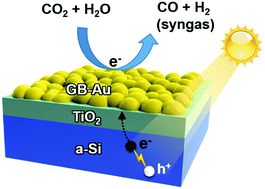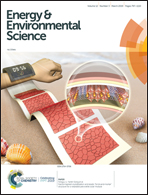Photoelectrochemical CO2 reduction to adjustable syngas on grain-boundary-mediated a-Si/TiO2/Au photocathodes with low onset potentials†
Abstract
A photoelectrochemical (PEC) CO2 reduction reaction (CRR) in an aqueous medium is among the most promising methods to produce renewable fuels with the sun and water as the energy and electron source. But a high negative bias remains a prerequisite to achieve an appreciable conversion at present due to the large overpotential of CO2 reduction. This communication describes a PEC CRR with low onset potential on an amorphous silicon (a-Si) photocathode decorated with grain-boundary-rich gold catalysts. Syngas, with high throughput and desirable CO/H2 ratios such as 1 : 2 and 1 : 1, was produced in a wide PEC range from the equilibrium potential E0(CO2/CO) of −0.1 V vs. the reversible hydrogen electrode (VRHE) to as positive as 0.4 VRHE, leading to a half-cell conversion efficiency of 0.42%. This performance represents the highest half-cell efficiency and lowest onset potential for CO2 reduction ever reported among aqueous PEC cathodes under 1 sun illumination. The a-Si/TiO2/Au photocathodes exhibit excellent stability in a wide potential range, with a high CO mass activity up to 180 ampere per gram of gold at −0.1 VRHE. Controlling the grain boundary provides powerful potential to adjust the product selectivity in PEC CO2 reduction.



 Please wait while we load your content...
Please wait while we load your content...